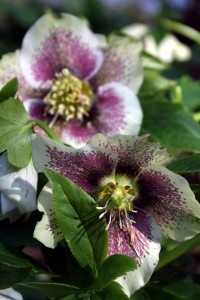22 October 2014
Fashionably Winter: the Helleborus
 Heading into winter is the time when the Helleborus (also known as 'Christmas Rose') will start to make a show for the garden. These are winter and spring perennials available in many forms and colours; they are almost an essential for any garden during winter months. There are many varieties of Hellebore and they are distributed widely across Europe and to as far as China and Syria. Identified by their leaves, their flowers are displayed in clusters which may be open and airy or tightly grouped. The flowers will show different forms from Anemone and centered to double, spotted or picotee. In the Helleborous flower, the true petals are modified into a ring of nectaries at the centre of the flower to attract pollinating insects, which make these great pollinator plants for your garden. Flowering time is late winter through to spring, and I find the way these delicate flowers withstand the harshest of weather really fascinating. Different varieties offer colours from purist white (Christmas Carol) to deep pink (Party Dress) and some will give a delicate two-tone colour (Helleborus ericsmithii). Most Helleborus will grow well in any reasonably fertile soil, but are happiest in lime and neutral soil and many enjoy a shady area, so for sun starved borders this is a real essential. For more open and sunny situations the more moisture they require. So for a fully hardy, delicate flowering perennial throughout winter, you will not go far wrong with the Christmas Rose. This Longacres blog post was contributed by Jo from our plants department
Heading into winter is the time when the Helleborus (also known as 'Christmas Rose') will start to make a show for the garden. These are winter and spring perennials available in many forms and colours; they are almost an essential for any garden during winter months. There are many varieties of Hellebore and they are distributed widely across Europe and to as far as China and Syria. Identified by their leaves, their flowers are displayed in clusters which may be open and airy or tightly grouped. The flowers will show different forms from Anemone and centered to double, spotted or picotee. In the Helleborous flower, the true petals are modified into a ring of nectaries at the centre of the flower to attract pollinating insects, which make these great pollinator plants for your garden. Flowering time is late winter through to spring, and I find the way these delicate flowers withstand the harshest of weather really fascinating. Different varieties offer colours from purist white (Christmas Carol) to deep pink (Party Dress) and some will give a delicate two-tone colour (Helleborus ericsmithii). Most Helleborus will grow well in any reasonably fertile soil, but are happiest in lime and neutral soil and many enjoy a shady area, so for sun starved borders this is a real essential. For more open and sunny situations the more moisture they require. So for a fully hardy, delicate flowering perennial throughout winter, you will not go far wrong with the Christmas Rose. This Longacres blog post was contributed by Jo from our plants department






